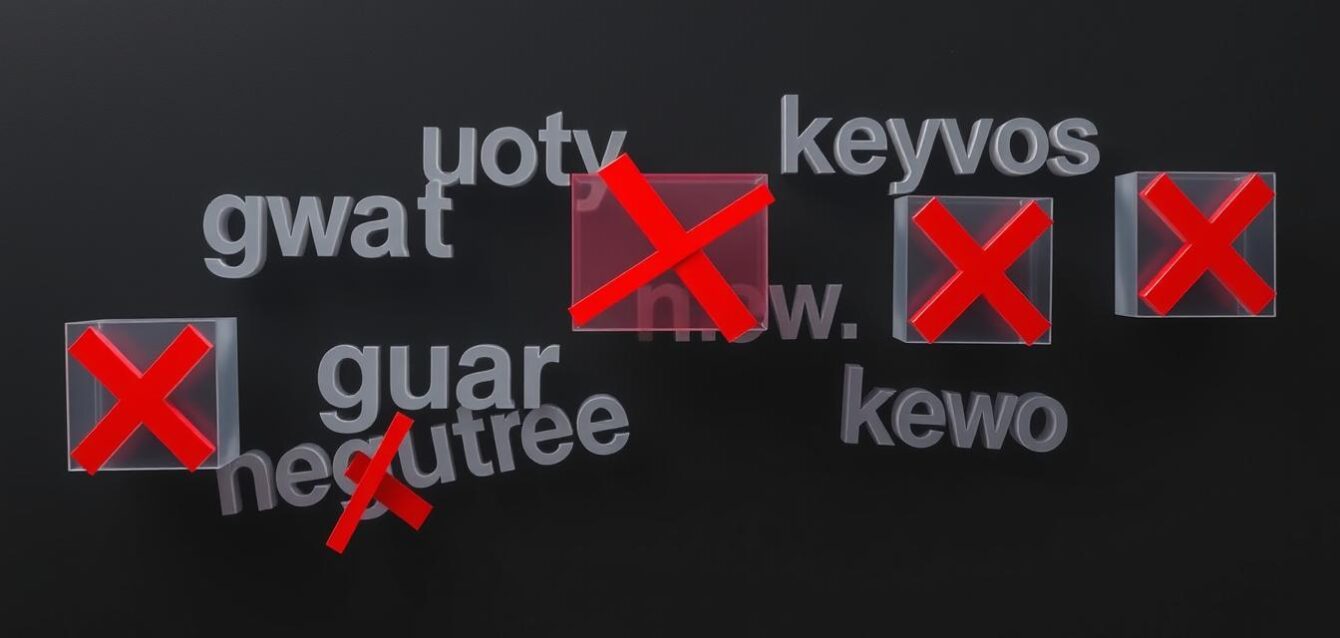Nearly half of advertisers add no exclusions each month — and that gap is fueling rising CPCs and wasted spend across premium accounts.
We see this pattern in audits: unchecked terms trigger irrelevant searches and dilute budget. The result is lower CTR, weaker Quality Score, and higher blended CAC.
Our mission is clear. We apply precise negative keyword strategies and list governance to filter irrelevant searches before they trigger ads. That preserves budget for high-intent queries that actually convert.
We promise a practical, scalable playbook that spans match types, campaign placement, and reporting cadence — grounded in platform data and real results.
Within days, a focused sweep reclaims spend and stabilizes delivery across Google, Microsoft, and Amazon. We’ve recovered seven-figure performance losses by enforcing term hygiene and ongoing reviews. Implement this guide or partner with us for a turnkey upgrade to your paid growth engine.
Key Takeaways
- Nearly 50% of advertisers skip exclusions, leaving ROI on the table.
- Account-level lists remove irrelevant terms like “cheap,” “jobs,” and “free.”
- Precision in match types boosts CTR and Quality Score quickly.
- Cross-platform governance cuts wasted spend and improves performance.
- Fast wins are available within days; compounding gains follow disciplined reviews.
The rising cost of clicks: Why wasted spend is your silent growth killer right now
As minimum bids creep up, every irrelevant search becomes a leak in your growth engine. Auction dynamics and rising CPCs mean a single off‑target query can erode margin and dilute budget reserved for high‑intent visitors.
We focus on protecting premium brands. Excluding low‑intent modifiers like “free,” “printable,” and “jobs” stops impression waste and restores return on ad spend quickly. WordStream data shows adoption of exclusions can deliver material savings in 30 days.
Hooking the problem: CPC inflation, irrelevant searches, and shrinking ROI
Wasted spend compounds silently: ads triggered by off‑target terms drive clicks that add no value. This inflates cost per acquisition and pressures growth plans.
What high-ticket brands stand to gain by tightening query controls today
- Protect brand equity by removing bargain-hunter searches like “cheap” and “free.”
- Boost CTR and lower average CPC through cleaner relevance signals.
- Reallocate spend to converting queries and scale with confidence.
| Issue | Immediate Fix | Expected Impact (30 days) |
|---|---|---|
| Off‑target searches | Exclude low‑intent terms at account and campaign levels | Lower wasted spend, higher ROAS |
| Rising CPCs | Increase relevance via targeted exclusions | Reduced CPC, improved margin |
| Brand erosion from bargain traffic | Block modifiers like “cheap” and “free” | Protected CAC and brand positioning |
Negative keywords explained: The filter that protects your budget and boosts relevance
Filters live at the query level, stopping irrelevant traffic before it touches your bids. A negative keyword prevents an ad from showing when specific words appear in a search. That means we show ads only to users who match intent, not just interest.

What they are and how they differ from target keywords
Target keywords command visibility: they tell platforms when to surface our ads. By contrast, a negative keyword tells the system not to surface an ad when low-value modifiers appear.
Real-world example and business impact
For example, a luxury travel brand bids on “luxury vacations” while excluding “cheap” and “free.” That simple list protects margins and lifts CTR.
- Mechanics: Blocked terms stop entire query combinations that dilute relevance.
- Outcomes: Cleaner searches raise CTR, improve quality score, lower CPC, and increase conversions.
- Governance: Maintain a curated list and review it often to scale safely across campaigns.
Mastering match types: Broad, phrase, and exact for precise exclusions
Choosing the right match type is the fastest way to stop wasted clicks and protect high-value traffic. We apply three inverse match logics to stop irrelevant searches before they touch bids.
Broad match negatives: catch-all coverage without overblocking
Broad match blocks terms in any order and captures many permutations across queries. It is the widest net for eliminating low-value traffic.
Use case: Gradual deployment on account lists to avoid hiding near-match converting searches.
Phrase match negatives: ordered control, platform-friendly
Phrase match stops the exact phrase with words before or after it. It balances safety and reach and transfers well between Google and Microsoft.
Practical example: Exclude “free shipping” as phrase match to remove generosity seekers while leaving “fast shipping” live.
Exact match negatives: surgical exclusions for traffic sculpting
Exact match blocks only the exact search. Use this when you must protect a campaign or ad group from a specific query.
Deploy exact match to route traffic precisely and preserve top-performing sets.
Nuances and close variants: what match types do and don’t block
Negatives do not always cover close variants or synonyms. That means similar searches can still slip through.
We monitor impression changes and expand lists when synonyms or variants surface in reports.
- Broad match: high coverage, test slowly.
- Phrase match: portable and safe for universal lists.
- Exact match: precise sculpting for ad group hygiene.
| Match Type | Behavior | Best Use |
|---|---|---|
| Broad match | Blocks terms in any order; widest coverage | Account-level nets for low-intent themes |
| Phrase match | Blocks the ordered phrase with words before/after | Cross-platform lists and campaign-level control |
| Exact match | Blocks the exact search only | Surgical ad-group exclusions and traffic routing |
Next step: codify match-type rules in your playbook, then measure impression shifts after each change to ensure we sculpt traffic, not starve it.
Where to add negatives: Account, campaign, and ad group for clean traffic architecture
A disciplined placement plan separates universal filters from surgical controls. We design layers so each search maps to the right funnel and your budget stays protected.

Account-level: Universal exclusions that save money across the board
At the account level we enforce brand-wide lists to block low-value intents like “free,” “jobs,” and “near me.”
These universal lists protect budget and keep corporate standards consistent as you scale.
Campaign-level: Theme-specific exclusions, including PMax controls
Campaign lists let us tailor exclusions to offers. Google Ads now supports campaign-level exclusions in Performance Max, so we curb irrelevant inventory without blunt account suppression.
Ad group-level: Prevent overlap and route queries to the right ads
Ad group filters are surgical. They stop cannibalization and ensure the right ad wins a given search term. Andrew Lolk cautions that account lists must be reviewed often so they do not block new product lines.
- Governance: quarterly audits and centralized ownership.
- Scalability: standard lists by persona and product for fast deployment.
- Measurement: log changes, watch impression shifts, and protect conversions.
How to find negative keywords using your search terms and keyword tools
We start with the data that matters. Pull the Search Terms Report, export it, and sort by impressions and spend to surface the highest-impact queries.
Mining the Search Terms Report: impressions, cost drivers, low CTR, and no-conversion terms
Sort by impressions and cost. Flag entries with clicks but zero conversions and CTR well below campaign averages.
Priority: treat items with more than 5–10 clicks and no sales as first candidates for exclusion. Manually sanity-check ambiguous queries with a quick Google search before you act.
Keyword Planner uses: spotting “free,” “printable,” and other irrelevant terms
Use Keyword Planner to scan suggested keywords for low-intent modifiers like “free,” “printable,” and “DIY.” Add repeat offenders into a staging list for review.
Pattern analysis: single-word breakdowns and N-grams to scale identification
Break reports into single words and N-grams to reveal recurring off‑intent tokens across many queries. Tools like Optmyzr expedite this and flag underperformers.
- Pull the top 20% of terms driving ~80% of wasted spend first for immediate ROI.
- Centralize validated offenders into account, campaign, or ad‑group lists.
- Log each change in-platform and in your optimization journal to measure impact over time.
- Automate recurring reports and run this workflow weekly for new campaigns; bi-weekly or monthly for mature programs.
| Step | Action | Outcome |
|---|---|---|
| Report pull | Sort by impressions & spend | High-impact candidates surfaced |
| Filter | Clicks >5 & zero conversions | Shortlist for review |
| Pattern analysis | Single-word & N-gram breakdowns | Repeat offenders identified |
Workflow discipline wins. We prioritize speed and central governance so campaigns recover wasted spend and scale with surgical precision.
Prioritize by impact: Building a high-leverage negative keyword list fast
We prioritize impact over perfection. Start with the handful of searches that drive the most volume and spend. That stops the biggest leaks and frees budget for high-intent traffic.
Start with high-volume and high-cost queries to stop the bleeding
We triage the top 50–100 search terms by impressions and cost. Focus on entries with clicks but no conversions first.
Act fast: bulk add negative keywords for the worst offenders, then run a 48–72 hour validation window to confirm improvements.
Cross-platform sanity: Phrase-match single-word negatives for Google and Microsoft Ads
For cross-platform consistency, we deploy phrase match on single-word exclusions. Microsoft Ads lacks broad-match negatives, so this approach reduces slip-throughs.
- Protect winners by excluding low-intent variants that cannibalize exact-match performers.
- Separate universal lists from campaign-level entries for clarity and speed.
- Document thresholds: e.g., no conversions after N clicks → block; borderline cases → bid down first.
- Time-box weekly sessions: ship changes, measure, and iterate to avoid analysis paralysis.
| Step | Action | Outcome |
|---|---|---|
| Triage | Top 50–100 by volume & spend | Immediate spend reduction |
| Deploy | Phrase-match single-word list (cross-platform) | Consistent blocking on Google Ads & Microsoft |
| Validate | 48–72 hour review | Confirm ROI lift and protect traffic |
Governance matters. Roll proven exclusions into shared lists, align merchandising and sales on availability, and ensure every new campaign inherits the baseline do-not-trigger list.
Negative Keyword Strategies for scalable growth
Reusable controls let teams launch campaigns without reworking exclusions every time.
Reusable lists: Universal, brand, competitor, and low-intent themes
We templatize growth. Build shared lists for universal filters, brand‑protect, competitor blocks, and low‑intent themes. These keyword lists speed launches and preserve budget across search and display.
Traffic sculpting: Using exact-match negatives to keep queries in the right ad groups
We apply exact match exclusions at the ad-group level to route high-value searches to the correct ads. This prevents cannibalization and improves CTR and relevancy.
Dynamic Search Ads and brand campaigns: Prevent cannibalization with smart exclusions
For DSA, exclude active keywords from automated campaigns so your brand campaign captures branded searches. In practice, add high-volume search terms as negatives in DSA to protect margin and discovery.
- Shared libraries ensure every new campaign inherits best-practice exclusions on day one.
- Audit lists quarterly and keep a changelog mapping searches and terms to exclusions.
- Test each list change independently to measure its impact on traffic and conversions.
| Use | Benefit | Example |
|---|---|---|
| Brand list | Protects equity | Block brand on generic campaigns |
| Competitor list | Reduce irrelevant clicks | Exclude competitor names |
| Low-intent list | Improve ROAS | Exclude “free” and “jobs” |
Outcome: a repeatable negative keyword strategy that scales governance, shields brand, and sculpts traffic with surgical precision.
Advanced routing and platform-specific tactics for Google Ads and Amazon
Advanced routing locks each search to the campaign best built to convert it. We design rules that channel brand searches to brand campaigns and keep generic searches in broader discovery funnels.
Channeling brand vs. generic: direct queries to optimal campaigns
We assert control: exclude brand terms from generic campaigns so they flow to dedicated brand campaigns at lower CPCs. For product-level campaigns, we block broad category searches to keep messaging tight and conversion-ready.
Bid-first, block-later: a tiered approach for borderline searches
Test before you cut. Reduce bids on borderline terms and monitor search performance for 48–72 hours. If traffic still wastes spend, then add exclusions. This preserves discovery while limiting waste.
Amazon workflow: auto-to-manual transfer and ACoS control
Review auto-campaign search term reports weekly. Promote high-converting queries to manual campaigns and add them as negatives in auto to prevent cannibalization. This process often reduces wasted spend by 15–30% and tightens ACoS.
- Protect exact matches by excluding lookalike terms from overlapping campaigns.
- Maintain hygiene: weekly reviews at scale, bi-weekly for smaller accounts.
- Document routing rules so future teams execute with confidence.
| Platform | Action | Expected Impact |
|---|---|---|
| Google Ads | Route brand searches to brand campaign; lower bids on borderline queries | Lower CPC, higher CTR |
| Amazon | Promote auto winners to manual; add back as negatives in auto | Reduced ACoS; higher conversion rate |
| Cross-platform | Segment product vs. category terms; codify playbooks | 15–30% less wasted spend |
“Routing rules and disciplined bids protect margin without sacrificing discovery.”
Measurement cadence: Proving performance gains and avoiding over-restriction
Regular measurement keeps gains real and prevents well‑intended cuts from starving demand.
We institutionalize cadence. For active launches and experiments, we review weekly. For mature programs, we run bi‑weekly or monthly reviews without exception.
Weekly and monthly reviews: volume, CTR, conversions, and cost trends
Track volume, CTR, CPC, conversion rate, and ROAS at campaign and ad‑group levels.
We require: a pre/post report window for each change and an annotated log that ties every action to clear data.
Watchouts: sudden impression drops and starving high‑intent traffic
If impressions fall sharply after a change, pause and reassess match types and thresholds.
Recover fast: loosen the term, shift to phrase or exact, or test with reduced bids before re-blocking.
Quality Score and efficiency signals to track after changes
Monitor Quality Score, expected CTR, and conversion efficiency. Improved quality_score validates your governance.
Also inspect assisted conversions and funnel shifts. Quiet upstream signals can show over‑suppression.
| Cadence | What to track | Action |
|---|---|---|
| Weekly (active) | Volume, CTR, cost trends | Validate changes; rollback if impressions crater |
| Bi‑weekly (stable) | Conversions, ROAS, search term shifts | Adjust lists, test borderline terms with bids |
| Monthly (mature) | Quality Score, assisted conversions | Ingest learnings into playbooks; schedule audits |
“We prove impact with repeatable reviews and transparent logs.”
- Annotate every exclusion in your report and compare clean pre/post windows.
- Automate dashboards to surface anomalies in real time and protect traffic.
- Close the loop: feed validated outcomes into shared playbooks so optimizations compound.
Common pitfalls to avoid when you add negative keywords
Old exclusion lists can be a hidden choke point. They often start as cost-saving fixes and end up blocking new demand when product lines shift.
Overdoing account-level lists as product lines evolve
We warn decisively: legacy blocks can silence profitable queries. Andrew Lolk notes that teams forget to revisit lists and accidentally stop traffic as assortments expand.
Governance actions:
- Schedule quarterly audits of every account list to retire outdated entries.
- Document the rationale for each exclusion so changes are reversible.
- Prefer precise match types over sweeping broad blocks on high-stakes campaigns.
- Test reduced bids on edge cases before permanent suppression to preserve discovery.
Example: when you launch a premium line, confirm that any “budget” exclusions won’t suppress cross-sell searches.
| Pitfall | Fix | Guardrail |
|---|---|---|
| Rigid account lists | Quarterly review and pruning | Audit log with owner and date |
| Blanket blocks | Switch to exact or phrase match | 72‑hour validation window |
| Operational misalignment | Merchandising sign-off on lists | Playbook update on launches |
“Regular audits and clear documentation prevent self-sabotage.”
Conclusion
A compact, repeatable playbook converts messy search queries into clean demand signals.
We recap the edge: a rigorous negative keyword strategy and keyword strategy filter irrelevant searches before they drain budget. Cleaner keyword lists and precise match type choices protect traffic and sharpen campaign performance.
Standardize reusable negative keyword lists at account and group level. On google ads and Amazon, disciplined exclusions cut wasted spend and preserve premium product positioning.
Measure weekly, report monthly, and add negative only where intent is clearly misaligned. Test bids first for gray cases to avoid starving discovery.
Ready to reclaim spend and lift CTR, conversions, and Quality Score? Book Macro Webber’s Growth Blueprint now. Limited onboarding slots each quarter—secure your spot to lock in compounding gains before peak season.



